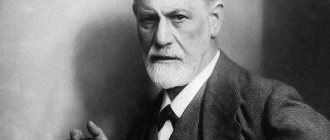The social nature of a person determines his ability to live in society and be part of it. The personality structure as such and the totality of the individual characteristics of a particular person provide him with the opportunity to be a subject of the sociocultural life of society.
Psychologists differ in their views and ideas about the content of the concept of “personality” and about the structure of personality. However, there are many very interesting theories that allow us to better understand the social nature of man and the peculiarities of the functioning of his psyche.
Psychoanalysis: the two-faced sphinx
Freud's theory of personality development formed the basis of many psychological movements of our time. Freud was born more than 160 years ago. But it is almost impossible to look at his works with a modern eye and give them even an unambiguous assessment. Another outstanding person, Charles Darwin, published his fundamental work “The Origin of Species” in 1859. Freud was only three years old at the time. But if Darwin's work determined the thinking of all subsequent generations (not counting believers radically opposed to his theory), then with the adoption of Freud's views the situation is completely different.
Opinions about his theory differ so much that a compromise is almost impossible to establish. Adherents of Freud's views consider him an outstanding scientist. They see his merit in the fact that he was able to see obvious facts that for some reason remained incomprehensible to other psychologists. There is another category of scientists - those who consider him not only lost among his own fabrications, but also regard Freud as a fraudster and a liar. Which side to take regarding the psychoanalysis discovered by Freud - everyone is free to decide for themselves.
Darwin's concept is not subject to such harsh criticism as Freud's theory of personality development. After all, there is a lot of evidence in its favor. In the scientific world, it has long been considered generally accepted, not counting some fanatics who are trying to push religious views into the sphere of science. But the arguments of psychoanalysis are often difficult to understand. The human mind resists all the evidence that Freud provides in his writings.
Why is psychoanalysis criticized?
Initially, Freud’s developments were accepted by Kudryashov I.S. Psychoanalysis and its prerequisites. Journal of Siberian Medical Sciences. with hostility, and his concept was accompanied by scandalous fame. In particular, Grünbaum A. opposed it. One hundred years of psychoanalysis: results and prospects. Independent Psychiatric Journal. Karl Jaspers, Arthur Kronfeld, Karl Popper and Kurt Schneider.
Although today the concept of psychoanalysis has many supporters, it is subject to serious criticism. Opponents of psychoanalysis doubt its effectiveness, and some researchers even declare Tallis RC Burying Freud. The Lancet. Freudian concept of pseudoscience.
A hot topic of criticism has been the concentration of psychoanalysis on sexual motives. For example, a number of researchers believe Kraepelin E. Introduction to the Psychiatric Clinic. M. 2004. that “rough digging into the sexual life” of patients can lead to adverse consequences for the psyche.
Disputed Kupfersmid J. Does the Oedipus complex exist? Psychotherapy: Theory, Research, Practice, Training. and Freud's concept of the Oedipus complex.
There is also Svartberg, M., Stiles, T.C. Comparative effects of short-term psychodynamic psychotherapy: a meta-analysis. Journal of consulting and clinical psychology. doubts about the effectiveness of psychoanalytic therapy. In 1994, a group of German scientists conducted Hoffmann-Richter U. Psychotherapie im Wandel - Von der Konfession zur Profession. Eine Auseinandersetzung mit einem bemerkenswerten Buch von Klaus Grawe, Ruth Donati und Friederike Bernauer. Psychiatric Praxis. study of 897 works on psychoanalysis. Scientists have concluded that long-term visits to a psychoanalyst are not effective for the patient and that psychoanalytic therapy increases the risk of worsening his condition. Only some mild disorders, according to the article, partially recede after psychoanalysis sessions. At the same time, behavioral therapy was twice as effective.
Noted Ackerman CE Psychoanalysis: A Brief History of Freud's Psychoanalytic Theory. Positive Psychology. also that the hypotheses and provisions of psychoanalysis are difficult to test experimentally, since this approach pays too little attention to the conscious in human behavior.
Psychoanalytic theory has also been criticized for its roots in Freud's sexist views, its inapplicability to non-Western cultures, and its excessive tendency to reduce everything to pathologies.
Opponents also criticize the methods of psychoanalysis. For example, psychologist Burres Frederick Skinner considered McLeod S. Psychoanalysis. Simply Psychology. The "ink blot" method is subjective and unscientific.
In addition, Freud himself is reproached by A. M. Rutkevich. How Freud adjusted the facts to his theory. Psychoanalysis. Origins and first stages of development: Course of lectures. M. 1997. in manipulation of facts. In 1972, Canadian psychiatrist and medical historian Henry Ellenberger found out Ellenberger HF The story of “Anna O”: A critical review with new data. Journal of the History of the Behavioral Sciences. , that there is no improvement in the condition of “Anna O.” Did not happen. That is, the very first case of cure using psychoanalysis actually turned out to be a fake. Subsequent studies established Rutkevich A. M. How Freud adjusted the facts to his theory. Psychoanalysis. Origins and first stages of development: Course of lectures. M. 1997. that Breuer stuffed the patient with morphine and chloral hydrate, ultimately making her a drug addict. Because of this, she spent another three years recovering from the consequences of “catharsis.”
Today it is known that “Anna O.” suffered Borsch-Jakobsen M. Souvenirs d'Anna O. Une mystification, centenaire. Paris. 1995. from dental disease. Freud’s own patient, “Cecilia M.”, also had the same illness. (Anna von Lieben), whom he persistently diagnosed as hysterical neurosis. It is also worth mentioning here the illustrative case of “Dora” (Ida Bauer). Freud believed that her pain was associated with nervous experiences, although in fact Ida was tormented by rectal cancer.
There are also subjective factors McLeod S. Psychoanalysis. Simply Psychology. , which make it difficult to determine whether psychoanalytic therapy is effective or not.
- It requires a lot of time, money and motivation and does not guarantee a quick “recovery”.
- During sessions, a person can reveal repressed painful memories, which will cause him even greater suffering.
- Psychoanalysis is not suitable for all people and not all illnesses.
However, there is Safran JD Psychoanalysis Today. Psychology Today. and the opposite point of view. For example, Canadian-American psychologist Jeremy Safran believes that some methods of psychoanalysis in conjunction with modern research have proven effective. And the American Psychological Association includes Psychoanalysis. APA. psychoanalysis is among its recognized practices and areas of specialist training.
Freud and his brainchild
However, even those specialists who disagree with the main tenets of Freudianism must recognize the enormity of his contribution - regardless of how many theses in Freud's works require verification and addition. After all, it was he who was the first to manage to study in detail and as honestly as possible the “animal called man.” Freud openly admitted that every person has to face the same question - how to live in civilization. After all, it is both the most amazing achievement of humanity and its colossal tragedy.
Civilization requires everyone to restrain their desires and passions. Freud did not wear “rose-colored glasses” - he looked soberly at how a person lives under these restrictions. It was Freud who first noted the negative aspect of upbringing and education. Adults dictate to the child what he can do and what he cannot even imagine. Despite the fact that Freud methodically destroyed all his biographical notes and letters, he was always ready to try on his own theory of psychoanalysis.
The scientist noted that very few people are able to openly admit such things that do not leave their reputation unnoticed. Therefore, often, while recording his most revealing dreams and difficult childhood memories, Freud often repented of such self-exposure. “Those who want to reproach me for such secrecy, let them try to be more frank than me,” the scientist wrote.
Freud's childhood and personality formation
A little biography
Freud was born on May 6, 1856 in the city of Freiburg in Moravia. The parents of the future father of psychoanalysis were Jews. Mother, Amalia Nathanson, was the second wife of Jacob Freud, who traded wool and fabrics. In 1860, the Freud family moved to one of the poor areas of Vienna. Then this city was like a medal, on one side of which there were waltzes, cafes and entertainment, and on the other - deep poverty.
There is a famous case when Jacob Freud told his son a story. “One non-Jewish representative threw my hat into a dirty ditch and shouted: “Hey, you! Save yourself while you're still alive! “And what did you do in response?” Freud asked his father. "Never mind. I just took out my hat and moved on." Little Zigi was surprised by his father's obedience. Isn't he a "strong" person? This picture greatly wounded the imagination of young Freud.
Having heard a humiliating story from his father, Freud from that time began to internally dream of revenge. He identified himself with the all-powerful Semitic Hannibal, who vowed to avenge Carthage. From a young age, Freud was able to control his anger, make his own judgments, and have endless respect for the Jewish people. The development of Freud's own personality took place on rather favorable soil. Despite the ambivalent attitude of the future father of psychoanalysis towards his parents, they loved their son very much and had many ambitious hopes for him. From a young age, Freud devoted time to reading the works of great philosophers - Kant, Hegel, Nietzsche. At the same time, he was also interested in learning foreign languages - even Latin came easily to him.
The professional development of a great psychiatrist
After graduating from school, Freud thought for a long time about what professional path to choose next. For representatives of his nationality then there was little choice. Neither law, nor industry, nor medicine aroused his interest. Freud focused on the latter, although he never became a doctor.
In 1885, Freud began interning with French psychiatrist Jean Charcot, where he first used hypnosis to treat mental illness. With his patients, Freud also began to use a special method that allowed them to speak out and thereby free their consciousness from negative content. His method was later transformed and is now known throughout the world as the “free association method.” Such conversations, built on fragments of phrases, helped the psychiatrist build a more complete picture of the problems of his patients. Over time, Freud completely abandoned hypnosis in favor of conversations in consciousness.
Freud's theory of personality development also revealed one of the fundamental truths for the scientific community. It lies in the fact that psychosis is a consequence of difficult memories for a person, from which he does not have the opportunity to free himself. At the same time, the scientist develops a theory about the influence of the Oedipus complex on personality development. This statement caused many scandals, with Freud himself being accused of being psychotic.
Personal defense mechanisms
Anxiety is a kind of warning that the Ego is in danger. Freud suggested that the Ego erects a kind of barrier against anxiety - defense mechanisms , which represent a subconscious denial or distortion of reality.
Defense mechanisms (psychological defenses of the individual) are certain types of behavior designed to protect the Ego (I) from anxiety generated by conflicts in everyday life.
1. Denial is the process of eliminating, ignoring the traumatic perception of external reality. For example, a terminally ill person denies the inevitability of death.
2. Substitution is the switching of id impulses from one object, inaccessible or fraught with a threat, to another, more accessible one. Those feelings and actions that should have been directed at the object that caused the anxiety are transferred to another object.
For example, replacing hostility towards your boss with pickiness towards your own child. In television reports about football matches, we often see how an attacker, who misses the target, sends the rebounding ball with a strong blow, in any direction. In this way, the accumulated energy is discharged.
3. Projection is a situation in which an anxiety-producing impulse is attributed to someone else. Most often, this is an unconscious mechanism through which impulses and feelings that are unacceptable to the individual are attributed to an external object and penetrate into consciousness as an altered perception of the external world.
He transfers (projects) his own desires, feelings and personality traits, which a person does not want to admit to himself because of their ugliness, onto another person.
For example, someone claims that in fact it is not he who hates his professor, but that he dislikes him. Or a stingy person, who, as a rule, sees in other people primarily greed, and an aggressive personality considers everyone around him to be cruel.
4. Rationalization is the reformulation of behavior in such a way that it becomes more understandable, more acceptable, and therefore less frightening to others. The function of rationalization is to disguise, hide from the consciousness of the subject the true motives of his actions, thoughts and feelings in the name of ensuring internal comfort, preserving self-esteem, self-respect.
Often this mechanism is used by a person to prevent the experience of guilt or shame. When this mechanism operates, the awareness of those motives that appear to be socially unacceptable or disapproved is blocked. A person, after some actions, actions dictated by unconscious motives, tries to understand them and rationally explain them, attributing to them more acceptable, more noble motives.
For example, you could claim that the job you just got fired from wasn't really that good.
5. Reactive formation is the replacement of one Id impulse with another, opposite to the first. A person hides impulses that disturb him by turning them into something opposite (alternatively, he can replace hatred with love). For example, someone who is constantly overcome by the desire to drink alcohol may suddenly become a passionate fighter for the passage of Prohibition.
6. Regression is a psychological defense mechanism consisting in the fact that a person, in his behavior when responding to very important situations, returns to early, childhood types of behavior that were successful at that stage.
The appearance in an adult of traits of childish, dependent behavior associated with happy times.
7. Suppression (repression) is the denial of the existence of some factor or event that causes anxiety. As a result of the action of this defense, thoughts, memories or experiences unacceptable to a person are, as it were, “expelled” from consciousness and transferred to the sphere of the unconscious, but at the same time they continue to influence the behavior of the individual, manifesting themselves in the form of anxiety, fear, etc. For example, involuntary repression from consciousness of certain memories or experiences that cause severe discomfort.
8. Sublimation is a change or replacement of some impulses of the Id through the switching of the energy of instinct to socially acceptable goals. There is a substitution of those needs that cannot be satisfied directly with socially acceptable goals.
For example, the transfer of sexual energy into the sphere of artistic creativity.
9. Identification is a defense mechanism in which a person sees another in himself and transfers to himself the motives and qualities inherent in another person. Identification also has a positive aspect, since with the help of this mechanism the individual assimilates social experience, masters new properties and qualities. For example, when using the identification mechanism, a person imitates the manners of some other person, whom he admires and who seems less vulnerable to him in alarming situations.
Levels of consciousness according to Freud
Freud divided the psyche into three levels - preconscious, conscious and unconscious. He is also the author of the division of personality into three components - “I”, “Super-I” and “It”. The preconscious level can perceive information with proper concentration. It refers to threshold perception. Memories fall into this category. People do not remember them every second, but with effort, these images will immediately appear in their imagination. Freud's theory of personality development assigns consciousness the role of “a sense organ for the perception of mental qualities.” But what interested him most was the unconscious. It is this that accommodates the natural needs of the body - primarily aggression and sexual energy.
Freud also divided human personality into three components. The "It" or "Id" is the most primitive of them. This part is located in the unconscious and exists on the principle of pleasure. It is here that the drives are contained - the instinct for life, called "Eros", and the instinct for death, "Thanatos". Personal development draws its energy from this part of the psyche.
What is included in the basis
Consciousness - what is it in psychology
Briefly, psychoanalysis can be presented as a method for studying psychological processes that are beyond consciousness. The theory takes into account the interrelation of all hypotheses about the functions and structure of the mental apparatus and considers them as a whole.
Modern psychoanalysis is based on the following areas:
- A theory that defines the behavior and development of an individual;
- Research of motives through free associations, interpretation of dreams. This allows us to bring out the hidden prerequisites that led to mental disorder;
- Treatment method, including:
- transfer and resistance analysis;
- interpretation of the source of conflicts (interpretation);
- elaboration as the final stage, leading to a restructuring of the psyche.
The main goal of the analyst is to rid the psyche of the subject of the hidden mechanisms that gave rise to conflict situations. This allows you to redirect the patient to the realization of positive desires and help him adapt to society.
What is hidden beyond consciousness
Additional Information. During the psychodynamic approach, the specialist tries to make the patient aware of the existence of unconscious conflicts, thereby influencing behavior and personal relationships.
Consciousness and "Ego"
The next part is conscious. The “I” or “Ego” is formed between 12 and 36 months of a child’s life. This is the part of the personality that is guided by reality. The ego has a specific task: to correlate its behavior with the environment in such a way as to satisfy the needs of the “Id”, without violating the requirements of society. The part called the “Super-I”, or “Super-Ego”, begins to function later than everyone else - between 3 and 6 years. It contains elements of personality such as conscience and ideals. The superego vigilantly ensures that social norms are respected.
All psychosexual stages of development occur in these components of the psyche. The opposition of the functions “It” and “Super-I” becomes the cause of neuroses and conflicts. In response to them, the “Ego” creates a number of defense mechanisms: rationalization, repression, regression, sublimation and others. However, at an early age there is a danger for a child to “get stuck” at a certain stage of personality development (as Freud said, “fixation” occurs at this stage). After all, the “Ego” is still quite weak. It is not capable of resolving all the existing conflicts that the “It” and the “Super-Ego” endlessly create for it. Then personal development follows the wrong trajectory.
Freud's theory of personality development in psychoanalysis
Freud believed that the stages of personality development occur according to the movement of libido (sexual energy) in the body. Over time, it moves between different parts of the body - mouth, anus, genitals. Freud was convinced that these stages are obligatory for every person, regardless of his nationality and cultural background. He identified the following psychosexual stages of development:
Oral developmental stage (0-18 months)
The source of pleasure at this stage is located in the mouth area. The baby satisfies one of its vital needs - feeding - by sucking the breast. Therefore, it is the oral cavity that is of interest to the baby, as well as everything connected with it - the tongue and lips. Here he feels pleasure. The sucking and swallowing that occurs during feeding is a prototype of every sexual act in the future. Freud believed that residual manifestations of the oral stage of development are also characteristic of adults. Behavioral patterns such as smoking, chewing gum, kissing, overeating - all of this is what Freud's theory of personality development calls attachment of libido to the mouth area.
Objects that bring pleasure to the baby for the first time in life are the mother's breast or nipple (with artificial feeding). But over time, the mother's breast ceases to be an object of love for the child. He replaces it with parts of his own body - which is why babies tend to suck their fingers or tongue to relieve tension. When breastfeeding stops, every baby experiences stress. The more powerful this stress is for the baby, the more libido is concentrated in the mouth area.
Part of the oral phase is the oral-aggressive stage, or the oral-sadistic stage. It occurs at the time when the child’s teeth appear. With the help of biting and chewing, he expresses his dissatisfaction when the mother is not around, or there is no opportunity to get pleasure. According to Freud, fixation at this stage leads to the fact that an adult likes to argue, turns out to be cynical, and displays a consumerist attitude towards others.
Anal stage (from 1 – 1.5 years to 3 years)
During this stage, sexual energy is concentrated on controlling bowel movements and urination. The main conflict here relates to “toilet training,” or potty training. The child learns for the first time to control his physiological needs. And if this happens successfully, then, according to Freud, the foundation is laid in the future for the formation of a creative and productive personality.
Success at this stage depends on how parents organize the learning process. If they praise the child and encourage him to use the potty, then the children feel capable and needed. You can hear a story from any mother about how her child, after using the potty, shows her the “result” of his efforts with a feeling of pride and self-satisfaction. The mother's joy in response further strengthens the child's self-esteem. After all, he has learned to control his own body and receives praise from an adult for this.
Freud's theory of personality development states that if parents are too strict or demanding in this regard, then fixation at the anal stage of the retaining type develops. The child, to spite his parents, tries to keep everything to himself. This is fraught not only with constipation in childhood, but also with the development of a certain type of personality. Such an adult will have a number of characteristic traits: stinginess, stubbornness, excessive punctuality, inability to put up with any type of uncertainty or disorder. This type is called anal-restraint. There is another method of fixation at the anal stage - anal-thrust. It develops when a child is potty trained too late. Such adults are characterized by excessive spending, anxiety, and even a certain sadism.
Phallic stage (from 3 to 5-6 years)
At this time, the child first begins to show interest in issues of sexual relations and the birth of children. He notices his own genitals. It is at this stage that the psychosexual drama develops, which Freud called the “Oedipus complex.” The boy discovers in himself a desire to solely possess his mother and eliminate his father from his path. At the same time, there is a fear of punishment from a stronger parent - “fear of castration.”
This conflict ends by age six. The child displaces love for his mother from consciousness and begins to identify himself with his father. He imitates his actions, statements, and behavior. Ambivalent feelings towards him (love and hatred) cease to exist - at least in the child’s mind. Imitating a parent of the same sex contributes to the formation of a “Super-Ego” in the psyche, or what is called conscience and ideals.
Personality development in girls also involves conflict at this stage. Freud calls it the “Electra complex.” The resolution of this conflict also occurs by identifying oneself with the mother.
Latent stage (6-7 – 12 years)
The phallic stage is followed by the “quiet” stage, or latent stage. Freud especially emphasized the importance of this stage of personality development on the formation of human culture and civilization as a whole. At this time, the child’s entire supply of libido is directed towards goals that have nothing to do with sexuality - friendship, knowledge of the world around him, sports. Sexual energy, no longer having its own object, is transferred to the universal heritage.
Parents are recommended at this stage to encourage any endeavors of the child. He should enjoy achievements in various fields of activity. At this time, the child becomes especially shy. If previously it was easy for a child to stand on a chair and recite poetry for an audience, now he may be afraid to go to the school board. At this time, girls can already fall in love with various idols - actors or singers, and boys - with their mother’s friends, singers. At this psychosexual stage of development, such falling in love is normal. Therefore, parents need to be sensitive to children's secrets, otherwise they can cause psychological trauma.
Genital phase (12-18 years)
The genital phase is the last in psychosexual development. It is caused by the onset of puberty and the physiological changes that occur in the body. There is a resumption of sexual and aggressive desires again, and the Oedipus complex can seriously worsen. The normal trajectory of personality development is considered to be the replacement of autoeroticism (when libido is directed towards oneself) with attraction to the opposite sex. In the genital phase, for the first time, a search for a sexual partner from one’s generation occurs, as well as attempts to determine one’s “place in the sun.”
Teenagers begin to show sexual activity for the first time, which often becomes the cause of promiscuity and bad experiences. At this stage, everything that stands in the way of teenage sexuality - religion, school, family upbringing - can negatively affect personality development. In this case, there is a “rollback” to the previous phases, the teenager becomes more aggressive, not finding an outlet for his sexual energy. Therefore, it is important for parents or teachers not to suppress his desires and not to let the teenager loose too much. You need to try to convey to him as much information as possible about the sexual sphere.
The product of a successfully completed genital phase is the genital character that Freud considered the most optimal and healthy. Its distinctive feature is a person’s ability to experience normal heterosexuality, without feelings of guilt or other conflicts. A mature personality, according to Freud, is not confined to one area - she is able to take care of others, bear responsibility, knows how to work, and is able to delay gratification when necessary.
Freud's theory of personality development highlights another distinctive feature of the genital phase - the acquisition of independence from parents. A person not only chooses a partner to survive the Oedipus complex, but also begins to engage in relationships with other people.
Three-component structural model of the psyche
In his early works, S. Freud singled out only the conscious and unconscious aspects of personality. The conscious part is small, as if it is only the tip of the iceberg, and in its essence is not significant. But the unconscious part is vast, occupying most of the iceberg. The subconscious mind contains the instincts and driving forces of human behavior.
Over time, Freud revised this simple division into conscious and unconscious and began to talk about the relationship between the three components of personality - Id (It), Ego (I) and Super-Ego (Super-I) .
1. Id (It) is a source of primitive biological drives and instincts, entirely related to the sphere of the unconscious. This is the most primitive and least accessible part of the personality; it is the original, primitive structure of the psyche. The id is closely related to biological drives (sleep, food, water, sexual desire, etc.) that energize human behavior.
Id stimuli demand immediate gratification without regard to anything else. They operate according to the pleasure principle, which seeks only opportunities to relieve tension by seeking pleasure and avoiding pain. The id is the main source of our psychic energy, libido, which manifests itself in the form of tension. An increase in libidinal energy leads to an increase in tension, which we then try in various ways to reduce to a normal level. For example, if a person is thirsty, he must satisfy his need for water. This will reduce the tension caused by thirst.
The id is like a small child who does not yet understand the rules of the world around him. He actively tries to get everything to satisfy his desires and needs, without assessing his capabilities and abilities, possible inconveniences for himself and others, as well as the consequences of his actions. For him, only “I want” exists, so the Id is controlled by the Ego.
2. Ego (I) is the rational and most conscious part of the personality, designed to adapt the impulses of the Id to social, economic and other restrictions imposed by the outside world.
This component of the psyche is responsible for decision making; this is the area in which intellectual processes occur. The ego seeks to express and satisfy the desires of the id in accordance with the requirements and restrictions imposed by the external world (in a way that is safe for the individual and adequate for society).
The ego is oriented toward causality and rationality, unlike the id. It follows the principle of reality, restraining the impulses of the id until a suitable object is found with the help of which the need can be satisfied and mental stress relieved.
The ego does not exist separately from the id. Moreover, the Ego derives its strength from the Id. The Ego itself exists, in fact, to help the Id.
3. Super-Ego (Super-I) is an internalized system of norms, rules and restrictions imposed on an individual by family and society, which is partly realized and partly remains in the unconscious.
The superego represents morality. From this it becomes clear why the Super-Ego cannot help but conflict with the Id, i.e. with a structure that does not recognize morality or any norms. Unlike the Ego, which tries to delay the fulfillment of the desires of the Id until a more appropriate opportunity, the Super-Ego intends to completely suppress these desires.
A person is not born with a Super-Ego. It is formed in the process of socialization - starting from the period when the child first learns what is “good” and what is “bad” and begins to distinguish between “right” and “wrong” (3-5 years). Children acquire a superego through their interactions with parents, teachers, and other “formative figures.”
As a result, the Ego appears, according to Freud, as an arena of continuous struggle between powerful and incompatible forces. He constantly has to maneuver between a rock and a hard place, trying to cope with the insistence and impatience of the id, correlate his actions with reality, relieve mental stress, and at the same time also deal with the continuous desire of the superego for perfection. In cases where the Ego is subjected to too much pressure, a situation called anxiety arises.
Childhood development and adult psychological conflicts
Freud considered childhood to be the period of life that has the most powerful influence on the development of the character of an adult. The famous psychiatrist was convinced that all the most important things in a person are formed before he reaches 5 years of age. Then he lives, trying to eliminate the conflicts of the past. “The secret of the human soul lies in the psychic dramas of childhood. Get to the bottom of these dramas, and healing will come,” Freud said.
Therefore, Freud's theory of personality development does not distinguish any special phases in adulthood. All symptoms of adult neuroses can be interpreted as a conflict between the Superego and the Id. The last part strives for sexual release, the first has the function of suppression. The “superego” makes a person feel guilty even if the discharge of the “Id” occurs symbolically.
Freud identified two types of neurotic disorders associated with a conflict situation in the present tense: neurasthenia, which is acquired as a result of excesses in sexual life, and anxiety neurosis, which occurs as a result of excessive suppression of sexual desires.
What is classical psychoanalysis
Archetype - what is it in psychology and philosophy
Sigmund Freud founded a theory that allows us to interpret the unconscious motives of people's behavior. Classical psychoanalysis in the modern sense means:
- a discipline based on scientific research;
- a set of measures studying mental processes;
- a technique used in the treatment of neurotic disorders.
Therapy is based on communication between the doctor and the patient, during which the latter shares his dreams, thoughts, and associations. The specialist analyzes the collected information, trying to identify unconscious conflicts.
At an appointment with a psychoanalyst
Then the hypothesis is transformed and brought to a conscious, understandable level. In this form, it is transmitted to the subject, who must accept it on faith.
Conclusion
The ongoing debate about the validity of Freud's theory of personality development should come as no surprise. It should come as no surprise that most people defend themselves against Freud's incriminating concepts. Freud himself believed that he was destined by fate to interrupt the “sleep” of humanity and tell them such an unpleasant truth about himself. As the great psychiatrist once told the writer Zweig, the main task of his theory is to teach a person to fight the “demon of irrationality”, while using the most rational principles of his mind.
Freud was very proud of his reputation as a “destroyer of illusions.” The product of his research work - psychoanalysis - became the main enemy of the deceitful politeness and secrecy of the society of that time. In 1930, in a letter to Albert Einstein, Freud wrote: “I no longer consider it one of my virtues that I always tell the truth whenever possible; it became my profession.”
Topics: Child psychology, Personal growth, For parents
What did Sigmund Freud do?
As soon as Sigmund got his first internship with one of the famous psychiatrists, he gradually began to rank mental illnesses. He realized that each person needs to be treated differently, and each needs a different approach. So, he tried to relieve some of their illnesses with the help of hypnosis, while others allowed them to simply speak out and throw out what had accumulated inside them. Sigmund Freud believed that in this way a person gets rid of oppressive and unnecessary burden, and this was already a step towards healing.










